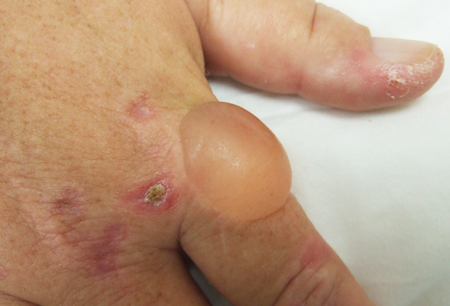Resumo
Definição
História e exame físico
Principais fatores diagnósticos
- presença de fatores de risco
- lesões cutâneas bolhosas
Outros fatores diagnósticos
- hiperpigmentação da pele
- hipertricose
- alopecia cicatricial
- urina vermelha
Fatores de risco
- sexo masculino, de meia idade, branco
- uso de bebidas alcoólicas
- tabagismo
- terapia estrogênica
- hepatite C
- vírus da imunodeficiência humana (HIV)
- mutação do gene da hemocromatose hereditária (HFE)
- mutações da UROD
- exposição a hidrocarbonetos aromáticos policíclicos halogenados
- níveis reduzidos de antioxidantes
- doença renal em estágio terminal
- diabetes mellitus
Investigações diagnósticas
Primeiras investigações a serem solicitadas
- porfirinas plasmáticas totais
- emissão de fluorescência plasmática
- porfirinas urinárias totais
- total de porfirinas dos eritrócitos
Investigações a serem consideradas
- fracionamento de porfirinas plasmáticas por cromatografia líquida de alta eficiência (HPLC)
- fracionamento de porfirinas urinárias por HPLC
- atividade eritrocitária da uroporfirinogênio descarboxilase (UROD)
- porfirinas fecais
- estudos de ácido desoxirribonucleico (DNA)
- Testes de função hepática
- ferritina sérica
- biópsia hepática
- biópsia de pele
- ensaio de imunoadsorção enzimática (ELISA) sérico para HIV
- anticorpos séricos de superfície da hepatite C
- creatinina
- ureia
- hematócritos
- hemoglobina
Algoritmo de tratamento
sem contraindicações à flebotomia
flebotomia contraindicada ou mal tolerada
recidiva após remissão
Colaboradores
Autores
Gagan Sood, MD
Associate Professor
Department of Medicine and Surgery
Baylor College of Medicine
Houston
TX
Declarações
GS is an author of a number of references cited in this topic.
Karl E. Anderson, MD
Professor
Departments of Preventive Medicine and Community Health and Internal Medicine
University of Texas Medical Branch
Galveston
TX
Declarações
KEA has received grants from the National Institutes of Health, the US Food and Drug Administration, and Alnylam Pharmaceuticals; he is an author of a number of references cited in this topic. KEA has received consulting fees, advisory board fees, and grants to the university from Alnylam Pharmaceuticals; consulting fees, advisory board fees, and grants from Recordati Rare Diseases; and consulting fees and grants from Mitsubishi Tanabe Pharma America.
Revisores
Robert S. Dawe, MBChB, MRCP(UK), MD(Glasgow)
Consultant Dermatologist
Honorary Clinical Senior Lecturer
Department of Dermatology
Ninewells Hospital & Medical School
Dundee
UK
Declarações
RSD declares that he has no competing interests.
Jeffrey P. Callen, MD
Professor of Medicine (Dermatology)
University of Louisville
Louisville
KY
Declarações
JPC declares that he has no competing interests.
Montgomery Bissell, MD
Professor and Chief
Gastroenterology
University of California
San Francisco
CA
Declarações
MB declares that he has no competing interests.
Créditos aos pareceristas
Os tópicos do BMJ Best Practice são constantemente atualizados, seguindo os desenvolvimentos das evidências e das diretrizes. Os pareceristas aqui listados revisaram o conteúdo pelo menos uma vez durante a história do tópico.
Declarações
As afiliações e declarações dos pareceristas referem--se ao momento da revisão.
Referências
Principais artigos
Phillips JD, Bergonia HA, Reilly CA, et al. A porphomethene inhibitor of uroporphyrinogen decarboxylase causes porphyria cutanea tarda. Proc Natl Acad Sci USA. 2007 Jan;104:5079-84.Texto completo Resumo
Jalil S, Grady JJ, Lee C, et al. Associations among behavior-related susceptibility factors in porphyria cutanea tarda. Clin Gastroenterol Hepatol. 2010 Mar;8(3):297-302;e1.Texto completo Resumo
Singal AK. Porphyria cutanea tarda: Recent update. Mol Genet Metab. 2019 Nov;128(3):271-81. Resumo
Handler NS, Handler MZ, Stephany MP, et al. Porphyria cutanea tarda: an intriguing genetic disease and marker. Int J Dermatol. 2017 Jun;56(6):e106-17. Resumo
Artigos de referência
Uma lista completa das fontes referenciadas neste tópico está disponível para os usuários com acesso total ao BMJ Best Practice.

Diagnósticos diferenciais
- Porfiria variegada (PV)
- Coproporfiria hereditária (CPH)
- Porfiria eritropoética congênita (PEC)
Mais Diagnósticos diferenciaisConectar-se ou assinar para acessar todo o BMJ Best Practice
O uso deste conteúdo está sujeito ao nosso aviso legal